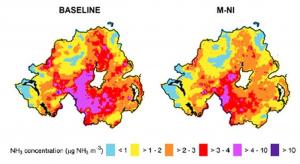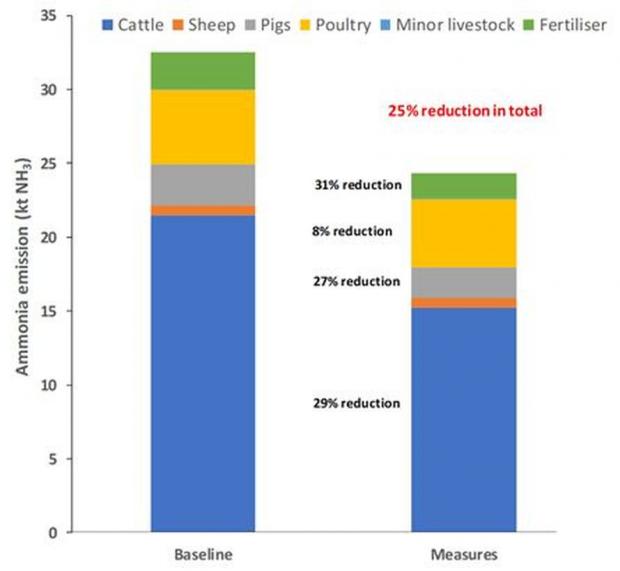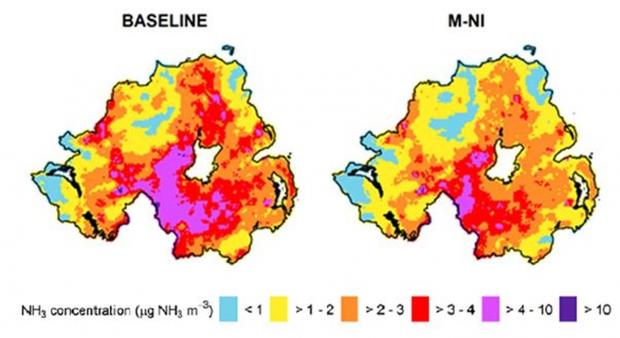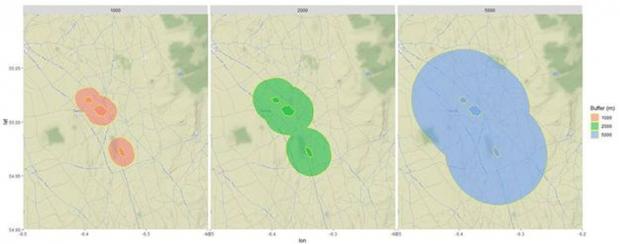Ammonia emissions from livestock present a major challenge for the Northern Ireland agricultural industry.

Funded by the Department of Agriculture, Environment and Rural Affairs, the Agri-Food and Biosciences Institute (AFBI) is currently conducting a major programme of research and have released this series of articles to help stakeholders understand the issue and adopt the solutions which will reduce emissions.
In December 2017, the Sustainable Agriculture Land Management Strategy (SALMS) Expert Working Group (EWG) published an annex to the SALMS ‘Delivering Our Future, Valuing Our Soils’ report entitled ‘Making Ammonia Visible’. This report outlined a suite of potential ammonia (NH3) reduction strategies of relevance to the Northern Ireland agricultural sector which, if adopted, should achieve significant reductions in agricultural ammonia emissions and consequent reductions in atmospheric ammonia concentrations and total nitrogen deposition on nitrogen-sensitive designated sites (SACs and ASSIs) across the province.
As part of the DAERA-commissioned scientific research programme on ammonia, AFBI, working in collaboration with Rothamsted Research and the UK Centre for Ecology and Hydrology (UKCEH), have now accurately quantified the impact of these reduction strategies on ammonia emissions from Northern Ireland agriculture, and the resultant atmospheric ammonia concentrations and total nitrogen deposition. The ammonia reduction strategies that were modelled, together with the assumed rate of uptake that may be possible across NI, are shown in Table 1.
| Strategy | Rationale | Assumed uptake rates |
| Lower crude protein diet for dairy, beef, finishing pigs, broilers and layers. |
Lowering the crude protein of diets to meet, but not exceed requirement, results in a reduction in nitrogen excretion |
75% |
| Genetic improvement in pigs and poultry |
Improving feed efficiency in pigs and poultry can result in a 5% reduction in nitrogen excretion |
75% |
| Extended grazing season (+2 weeks) |
Ammonia emissions from grazing beef and dairy animals are significantly lower at pasture than in housing |
100% |
| Low-emission livestock housing - cattle |
Novel flooring systems such as grooved floors or slat mats and increased scraping frequencies can significantly reduce housing emissions |
25% beef
|
| Improved structure of dairy cow collecting yards |
If collecting yards are covered with roofs and are scraped more frequently ammonia emmissions can be reduced |
15% |
| Low emission livestock housing - pigs and poultry |
A range of options are available to reduce emissions from pig and poultry housing such as flooring solutions for pigs, frequent belt removal of manure for layers and alum addition to litter for broilers |
25% pigs 60% layers 15% broilers |
| Covering above-ground slurry stores |
Covering outdoor slurry stores using a combination of flexible/ floating and rigid |
30% |
The modelled Northern Ireland-wide scenario was developed around what were considered to be realistic uptake rates (outlined in Table 1) for the individual reduction measures in a 5-10 year period. The application of the reduction strategies, at the uptake levels noted in Table 1 resulted in a 25% reduction in agricultural ammonia emissions across Northern Ireland (Fig. 1). This 25% reduction in ammonia would allow Northern Ireland to fulfil its contribution to the UK reduction target of a 16% decrease over 2005 levels by 2030, as set out in the Gothenburg Protocol and UK Air Quality Strategy.


Targeting of Ammonia Reduction Strategies to Specific Areas
Ammonia is a highly reactive gas and a large proportion of emitted ammonia will be deposited to ground rapidly and relatively close to the emission source. The remaining proportion of emitted ammonia will interact with other atmospheric components forming ammonium aerosols. These more stable compounds can travel much larger distances and be deposited through longer-range dry deposition or through precipitation (“wet deposition”) rainfall. Targeting of ammonia reduction strategies to key sources of emissions which are in the vicinity of nitrogen-sensitive designated sites has been shown to be more cost-effective per unit of emission reduction than country-wide measures.
With this rationale, a series of geographically targeted interventions were modelled for Northern Ireland, in addition to the reductions achieved in the Northern Ireland-wide ammonia reduction scenario. These targeted interventions took the form of enhanced ammonia reduction measures, i.e. measures similar to those applied nationally from Table 1, but with more ambitious uptake rates, applied within circular zones of 1, 2 and 5km from the boundary of each nitrogen-sensitive designated site (Fig. 3).

The targeted measures resulted in several additional designated sites being brought out of critical ammonia levels exceedance, with 1 additional SAC and 5 additional ASSIs returning to favourable status under the largest 5km buffer zone scenario.
The targeting of ammonia reduction strategies is on average 4 times more effective than non-targeted strategies at reducing ammonia concentrations for SACs. However, different sites respond differently to ammonia reduction measures because the make-up of their local emission sources is different.
In general, nitrogen-sensitive designated sites located near intensive agricultural land use, such as lowland bogs, respond well to geographical targeting, as dry deposited ammonia from local sources will be the predominate form of atmospheric nitrogen input to these sites. The targeting of reduction strategies in the vicinity of these types of sites will significantly reduce these local ammonia sources.
For nitrogen-sensitive designated sites further away from intensive agricultural land use such as upland moor / mountain sites, geographical targeting of reduction strategies is less effective, as nitrogen deposition at these sites is generally dominated by longer range or background nitrogen sources including wet deposited ammonium. Significantly reducing these longer range inputs requires a regional approach to tackle regionally elevated concentrations and for some sites will require the addressing of transboundary long-range nitrogen inputs.
Therefore, maximising the effectiveness of ammonia reduction measures will require an approach that combines country-wide measures to decrease ammonia concentrations region-wide from a high baseline, and selective local targeting of measures to decrease ammonia concentrations and local nitrogen deposition at nitrogen-sensitive sites where there are high emission densities in close proximity.
Overall this work provides an insight to the effectiveness of reduction strategies applied at NI scale and has been used to inform DAERA’s forthcoming Ammonia Strategy.
Over the coming weeks, this series of articles focusing on the AFBI research programme to address ammonia emissions in NI will outline the work being undertaken in more detail and the key findings to date.
Next week’s article will focus on the economics of the ammonia reduction measures modelled and identify those measures which are the most cost-effective at reducing ammonia emissions.
You can view previous articles in the series below:
- Article 1: Tackling Agricultural Ammonia Emmissions in Northern Ireland
- Article 3: The cost of tackling Ammonia Emmissions
Notes to editors:
AFBI is an arms-length body of DAERA delivering research and development, diagnostic and analytical testing, emergency response capability and expert scientific advice for DAERA and other government departments, public bodies and commercial companies in Northern Ireland, and further afield.
AFBI’s Vision is “Advancing the Local and Global Agri-Food Sectors Through Scientific Excellence”.
AFBI’s core areas:
- Leading improvements in the agri-food industry;
- Protecting animal, plant and human health;
- Enhancing the natural and marine environment.
Latest news
- AFBI issues Nematodirus warning – Spring 2025 11 April 2025
- Managing Nature Based Risks to the UK Economy and Opportunities for Green Finance 08 April 2025
- AFBI Hillsborough host AERA committee 27 March 2025
- The Omics Days Conference 27 March 2025
